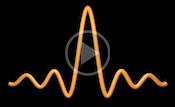Chapter Four: Synthesis

2. Synthesis Waveforms
Waveforms determine the spectral content output by an audio-rate oscillator. In subtractive synthesis, an oscillator is normally at the beginning of the audio chain. The waveform output by the oscillator is selected for its spectral characteristics. Filters farther down the audio chain then 'subtract' or modify frequencies in that spectrum. Additive synthesis relies on many oscillators chained together, each normally producing a sine wave (which produces only the fundamental frequency) with their outputs being summed, to build up a timbre from scratch. Both methods are still very much in use in digital synthesis applications.
Early modular synthesizers, such as the Moog modular models, c. 1967, provided the user a choice of four basic waveforms on their oscillators, believing they offered a good variety of choices for the subtractive synthesis process. It is important when studying the characteristics of these waveforms to take into account not only the partials each form produces (see Ch.1 waveshape), but also the strength of those partials. These two factors combined form what we consider timbre and together are called the waveform's spectrum. As discussed in Chapter One, the fact that these are periodic waveforms means that they will have harmonic partials. Below is a chart indicating these spectra for the four basic waveforms (p# = partial number, 'Relative Strength' is the relative amplitude of the other partials in relationship to the fundamental).
Mobile users, swipe tables sideways| Waveform | Shape/Sound click image to play/pause |
Spectrum | Relative Strength |
|---|---|---|---|
| sine wave |

|
fundamental only, no additional harmonics | n/a |
| triangle wave |
 |
odd partials only (1,3,5,7...) |
1/p#2 (3rd partial=1/9, 5th partial=1/25, etc.) |
| sawtooth wave |
 |
all partials Sometime called a ramp wave, can have 'up' or 'down' slope, which doesn't effect spectrum unless mixed with another wave. |
1/p# (2nd partial=1/2, 3rd partial=1/3, etc.) |
| pulse wave |
 |
Determined by duty cycle (see box below) | 1/p# |
pulse wave duty cycle = x:y with x = length of the shortest phase and y = the length of the entire cycle, not just the other phase.
With x = 1, all integer multiples of y are missing from the spectrum.
A 1:3 duty cycle, for example, would have partials 1,2,4,5,7,8…but be missing 3,6,9…
A square wave, which is a type of pulse wave, has a duty cycle of 1:2 and has only odd-numbered partials. It sounds brighter than a triangle wave, even though they both have only odd # partials because they diminish arithmetically, not exponentially in strength.
While a pulse wave can use a variety of impulse shapes, analog synthesizers tend to use the rectangular function, pictured above.
Current software synthesizers and music programming languages may offer additional waveforms to those listed above. While primarily used in the digital domain, they are listed here for completeness.
| Waveform | Shape/Sound click image to play/pause |
Spectrum |
|---|---|---|
| bandlimited pulse train or bandlimited impulse train |
 |
With the advent of digital synthesis, strong upper partials of a sawtooth or pulse wave may noticeably alias as they spread above the Nyquist frequency. Therefore, a waveform with a finite number of partials that cease at a certain frequency, known as bandlimited, is often used either directly or as part of additional synthesis techniques. The sinc function, not to be confused with sync (which coordinates the phases of multiple oscillators of a synth), is one such form. In digital synthesis languages, a function that utilizes this waveform is often called BUZZ, because of its strong, buzzy-sounding complete spectrum of equal-amplitude partials. NI Absynth, for example has Midbuzz and Highbuzz waveforms…explore their sound and partials. |
| stairstep or staircase wave |
 |
The cycle of this step-wise waveform can contain 2 to an inf number of steps, and while its spectrum is similar to a buzzy pulse wave, it is frequently used as a control signal where stepwise modulation is desired. |